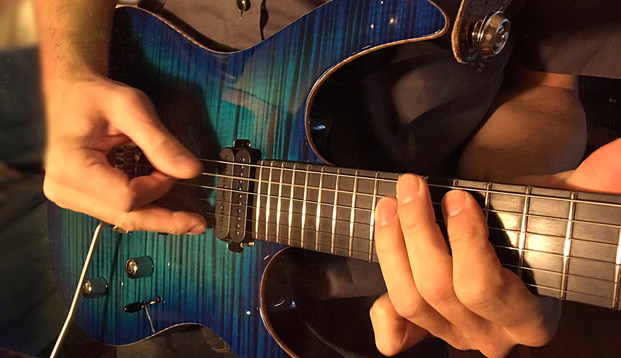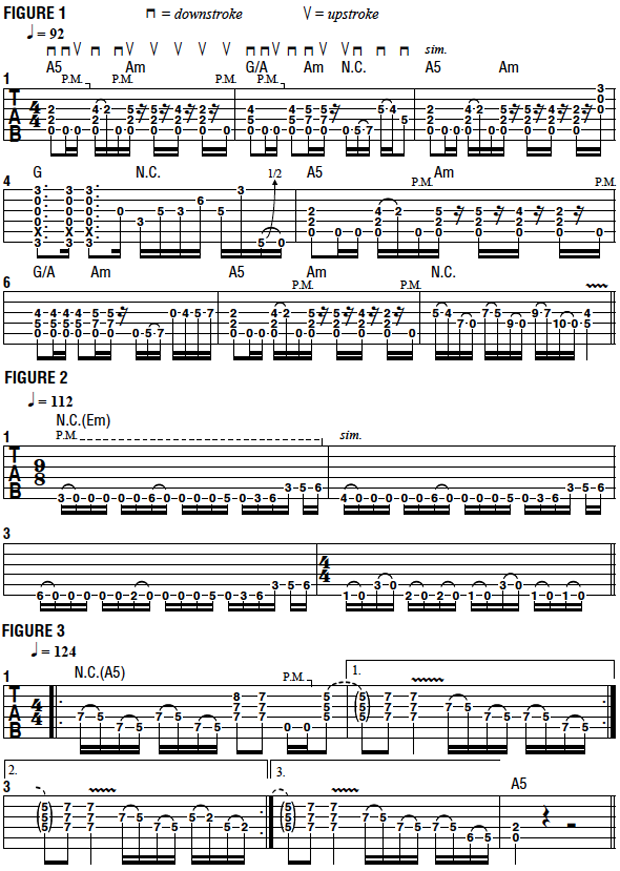Combining Metal-Style Rhythm-Playing Techniques to Create Memorable Riffs
Learn a handful of riffs designed to sharpen up very specific and different aspects of your heavy-metal guitar technique.

As a working metal guitarist, I’m always faced with different challenges, whether I’m working with an artist like Rob Halford from Judas Priest or fronting my own band and performing my own music.
In both situations, I’m required to come up with inspired, heavy metal–approved guitar parts that will fuel the music in an ideal way. Whether a specific guitar part is comprised of single-note lines against a pedal tone or fast-shifting chord voicings against different root notes, it’s essential that I have my rhythm/riff chops together for whatever situation I find myself in.
In this month’s column, I’d like to detail a handful of riffs designed to sharpen up very specific and different aspects of proper heavy-metal guitar technique.
FIGURE 1 presents an eight-bar rhythm part built using a few different techniques. I begin in bar 1 with an A5 power chord, followed by open-A-string pedal tones that alternate against two-note chords on the D and G strings. There is an inherent melodic line played on the G string through this bar. In bar 2, I move to two-note voicings of G and Am, played against the A pedal, after which I wrap up the initial two-bar idea with a single-note line.
Now that a theme has been established, in bar 3 I restate the riff from bar 1, and in bar 4, I wrap up this two-bar figure with a very unusual line that moves between the third and fifth frets on the D and G strings.
To me, this line has a Randy Rhoads–like quality. Bars 5 and 6 are very similar to bars 1 and 2, except I end this phrase with an alternative melody. Bars 7 and 8 complete the idea, wrapping with a very specific idea.
A three-note phrase, played in straight 16th notes, ends with a pull-off to the open D string. This three-note phrase moves up to each higher interval within the scale structure of the A Aeolian mode (A B C D E F G) until I finish on a two-note G major chord. Play through this eight-bar phrase slowly and carefully, striving for crystal-clear articulation as well as a rock-solid rhythmic feel.
One of my favorite things to do is devise metal riffs played in odd meters, such as 7/8 and 9/8. FIGURE 2 offers a riff in 9/8 that is performed almost entirely on the low E string. I begin with an index-finger pull-off from the third fret to the open low-E pedal note, and after riding on the low-E pedal in straight, palm-muted 16th notes for four more notes, I pull off from Bf at the sixth fret.
The phrase in bar 1 ends with an ascending line that comes in at an unusual place, on the second 16th note of beat four. Notice that there are two extra 16th notes in the bar, which results in a phrase played in 9/8. As the riff progresses, these pull-offs are moved to different locations, and the riff ends with repeated pull-offs on the bottom two strings.
FIGURE 3 is a little more straight-ahead, in terms of Maiden/Priest-type metal. Based primarily on A minor pentatonic (A B C D E), repeated pull-offs on the D and A strings are followed with three-note chord accents. Each two-bar phrase ends with a different descending line.
Now that you have the idea, try putting these techniques to use in your own metal riffs.

Get The Pick Newsletter
All the latest guitar news, interviews, lessons, reviews, deals and more, direct to your inbox!
"Upgrading from your entry-level acoustic opens the door to an entirely new world of tonewoods, body shapes, and brands": 6 signs it's time to upgrade from your first acoustic guitar
"I'm past my prime": 5 common excuses for not learning the guitar – and 5 body and mind-boosting reasons you should







![Joe Bonamassa [left] wears a deep blue suit and polka-dotted shirt and plays his green refin Strat; the late Irish blues legend Rory Gallagher [right] screams and inflicts some punishment on his heavily worn number one Stratocaster.](https://cdn.mos.cms.futurecdn.net/cw28h7UBcTVfTLs7p7eiLe.jpg)


